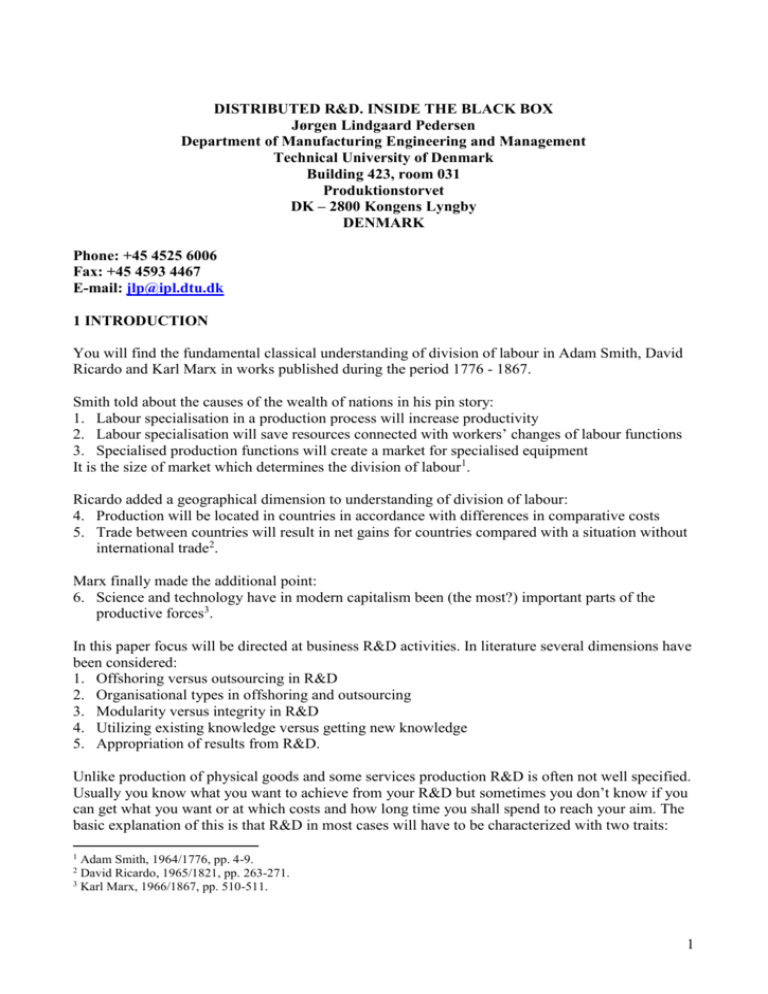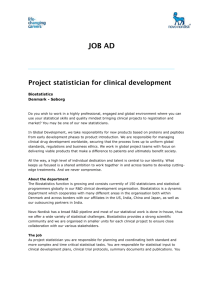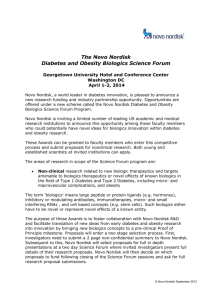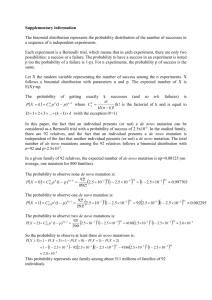Distributed R and D. Inside the Black
advertisement

DISTRIBUTED R&D. INSIDE THE BLACK BOX Jørgen Lindgaard Pedersen Department of Manufacturing Engineering and Management Technical University of Denmark Building 423, room 031 Produktionstorvet DK – 2800 Kongens Lyngby DENMARK Phone: +45 4525 6006 Fax: +45 4593 4467 E-mail: jlp@ipl.dtu.dk 1 INTRODUCTION You will find the fundamental classical understanding of division of labour in Adam Smith, David Ricardo and Karl Marx in works published during the period 1776 - 1867. Smith told about the causes of the wealth of nations in his pin story: 1. Labour specialisation in a production process will increase productivity 2. Labour specialisation will save resources connected with workers’ changes of labour functions 3. Specialised production functions will create a market for specialised equipment It is the size of market which determines the division of labour1. Ricardo added a geographical dimension to understanding of division of labour: 4. Production will be located in countries in accordance with differences in comparative costs 5. Trade between countries will result in net gains for countries compared with a situation without international trade2. Marx finally made the additional point: 6. Science and technology have in modern capitalism been (the most?) important parts of the productive forces3. In this paper focus will be directed at business R&D activities. In literature several dimensions have been considered: 1. Offshoring versus outsourcing in R&D 2. Organisational types in offshoring and outsourcing 3. Modularity versus integrity in R&D 4. Utilizing existing knowledge versus getting new knowledge 5. Appropriation of results from R&D. Unlike production of physical goods and some services production R&D is often not well specified. Usually you know what you want to achieve from your R&D but sometimes you don’t know if you can get what you want or at which costs and how long time you shall spend to reach your aim. The basic explanation of this is that R&D in most cases will have to be characterized with two traits: 1 Adam Smith, 1964/1776, pp. 4-9. David Ricardo, 1965/1821, pp. 263-271. 3 Karl Marx, 1966/1867, pp. 510-511. 2 1 1. Uncertainty 2. Complexity Modern thinking about division of labour has as its point of departure Herbert A. Simon’s work from the beginning of 1960s4 . His interest was about modularity in general with focus at physical production. After Simon other authors have tried to develop more general theories about division of labour using keywords as distributed R&D or modularity. Interest in division of labour specific directed towards R&D can be found to have its origin in empirical studies with very different examples. One type of cases can be where some small product modification activities are taken place in connection to outsource or offshore production where the products are to be sold on local market. Another type can be identified from pharmaceutical R&D where you have a very standardized way to develop and test products in development, clinical trials phase 1, 2 and 3 (sometimes a phase 4 called post marketing trial done after approval from the authorities will be included). Here it is possible to identify these phases and perform one of these in a country far away from the country in which the company doing R&D projects has its head quarter and other R&D activities. However it shall be stressed that development in division of labour in R&D including splitting up a project with people working together in different parts of the world in some cases has as a counterpart establishing of a geographically joint R&D project with people moved from different parts of the world to one place. Finally it shall be stressed that technology matters. Some technologies have been build on well developed science with theory and well tested hypotheses. Other technologies have a more ad hoc theoretical foundation with a substantial case by case design. Gary P. Pisano has given interesting examples of this point5. He compares analytical chemistry and modern biotechnology which can be used to produce analogue products but with very different processes. From literature and from case studies performed by myself sometimes in cooperation with colleagues or students it is clear that different dimensions matter in respect of division of labour in R&D How well understood is the technology field and its scientific foundation understood by people to organize, manage and perform the R&D work, in short which heuristics can be used? Potentials and challenges in knowledge, competences and economic terms connected with offshoring or outsourcing of R&D. Alternatives to modularity in R&D e.g. integrated design 2 A SIMPLE MODEL 4 5 Herbert A Simon, 1962 Gary P. Pisano, 1996 2 1. Innovations or technical and organizational changes to something new with practical application in large scale, are important characteristic of capitalist economies not only today but in general. First of all because higher profits in companies in general presuppose new processes in production with lower unit costs than before and/or new products with higher profit margins. 2. Lower costs usually presuppose new process technology with other amounts and/or types of inputs. Naturally lower input prices e.g. energy or raw material prices can give higher profits. Usually such growth in profits will disappear after some time and cannot give a permanent higher level of profits. But also technology based cost reduction will disappear as a source for profit when the new process has been standard technology in competitive companies. 3. Higher profit margins with given process technology and input prices usually presuppose new products which temporarily can command higher prices than will be sustainable in the longer run. 4. An important consequence from point 2 and 3 above is that innovations are embedded in standard life of capitalist companies – innovate or die! Further feed back effects can come from rising real income which can change final demand from consumers. 5. Innovations are more than technology based e.g. they can have important social or psychological dimensions. 6. If innovations are focused towards large or fast growing markets it will be important that uncertainty about quality and efficiency has been reduced to a very low level. Simply because non – fulfilment of these claims can result in heavy economic losses. The most efficient way to achieve that quality level will be to base research, development and test on “objective” and “true” knowledge. Traditional scientific methods in Western science and technology are designed to secure objectivity and truth quality of results. So reduction of technical uncertainty is a necessary but not sufficient precondition for reduction of commercial uncertainty. 7. The rising demand of scientific and technological knowledge about nature, social conditions, processes and structure and consciousness means that the economic weight of these activities will grow both as costs but also as determinants of income including profit. 8. From basic economics we shall expect that growing production of R&D will go in direction of saving variable inputs and costs and instead substituting fixed inputs and costs. In this way production costs for R&D results will be minimized. For example in biotechnology mapping the human genome will make it much easier to develop knowledge about specific diseases and developing new drugs to cure such diseases. When we have developed such a genetic map the research and development work will be much easier and cheaper and can expand into a much bigger field. 3 3 DISTRIBUTED R&D IS NOT THE SAME AS DISTRIBUTED COORDINATION AND CONTROL In a contribution by Alexander Gerybadze and Guido Reger some interesting observations have been made on differences between spatial distribution of learning and R&D activities on one side and spatial distribution of coordination and control on another side6. The main point is that large multinational corporations today often have changed their innovation process chains and now are thinking in terms of integrated process chains7. Instead using the traditional institutional separation of basic research, applied research, development, production and application a change into close linkages between research, production and marketing have been important for getting higher profitability8. These new trends in innovation management are giving rise to important changes in management within corporations e.g. coordination of transnational and multidisciplinary projects and between independent corporations e.g. new forms of joint R&D projects9. From an empirical study of R&D internationalization process in 21 multinational corporations with head quarters in Europe, U.S.A. and Japan some new tendencies were identified in the end of 1990s: 1. R&D is located in the most dynamic and forward-driving markets 2. R&D is located close to the point-of-sale 3. Active presence in locations where regulatory conditions, licensing procedures and standardization agreements facilitate rather than constrain the innovation process is an important driver for performing innovation abroad 4. For certain complex and sophisticated new products close linkage between R&D, advanced manufacturing and an efficient supplier network are decisive 5. Some research intensive companies in particular fields emphasize access to unique resources and leading research results and talents in particular centers of excellence with a strong international reputation 10 What is very interesting in the Gerybadze and Reger article is their stress on two different trends in R&D locations: 1. An on-going process with setting up R&D laboratories and product development activities in different places in the world 2. An even more consistent concentration and refocusing of activities The first trend mentioned above has resulted in very complex and unmanageable organizational structures and processes. This has induced firms to search for more effective types of managing their international portfolio of innovation activities11 . So on one side we can observe a trend to a more global spread in R&D activities and on another side a trend to more centralization in decision 6 Alexander Gerybadze and Guido Reger, 1999, pp. 255-257 Gerybadze and Reger, op cit, p. 258 8 Gerybadze and Reger, op cit 9 Gerybadze and Reger, op cit 10 Gerybadze and Reger, op cit, pp. 261-262 11 Gerybadze and Reger, op cit., p. 263 7 4 power in R&D. The explanation of this development is according to the authors to be found in a combination of type of innovation according to science and research based innovation versus coupling of market with R&D and innovation with country of origin in innovation12. In most literature about globalization of R&D only division of labour in its geographical spread has been studied. That is a partial view of the development because we cannot understand motives and resources behind the multinational corporations’ decisions. In this paper I shall look at distribution of R&D from three perspectives or angles: A science and technology perspective An offshoring or outsourcing company perspective A geographical perspective 4 SOME EMPIRICAL OBSERVATIONS The empirical material used in the following is from interviews with senior management often vice presidents responsible for R&D, company websites and in some cases from articles about relevant companies. All companies are Danish in that sense that they have their head quarters in Denmark. Material used below is from pharmaceutical industry. Other material which has been collected but not used in this paper is from hearing aid industry, industrial enzymes, measuring equipment and engineering companies in design of cement machinery and in design of marine engines13. 4. 1 Pharmaceutical industry We have two pharmaceutical research based companies as cases in this paper. The first is Novo Nordisk A/S and the second is H. Lundbeck A/S. Novo Nordisk was established in 1925 as Novo after a split of a company established in 1923 with the production of insulin based on extraction of insulin from cows as its product. After that split there existed two producers of insulin in Denmark. They were merged again in 1989 as Novo Nordisk A/S. During time the two companies have taken other products into their portfolio – human growth hormone, medicine for treatment of persons with haemophilia and as an important new product line industrial enzymes which today has been moved into an independent company Novozymes but owned by Novo A/S which majority owner is the Novo Nordisk Foundation which has as its goal to be a stable base for business and research in Novo Nordisk A/S, Novozymes A/S and other companies in which the Foundation has essential ownership, support medical research and development and support other scientific, humanitairian and social purposes14. But the most important purpose is to prohibit a development in which non-Foundation interest would lose its majority in Novo A/S. Profit is a mean for achieving this goal not an autonomous goal. The Novo Nordisk Foundation has a majority of the voting power of the shares. 12 Gerybadze and Reger, op cit, pp. 264-266 Will be published in a coming paper 14 Novo Nordisk fonden 13 5 When recombinant DNA technology just after the technology first time had been demonstrated to work in 1973 became relevant in pharmaceutical product development Novo’s top management decided that they had to develop a human insulin product one of the reasons being that their main competitor American Eli Lilly and Company had started such a development project15. However Novo had to acknowledge that they didn’t had competences and experiences at that time in the end of 1970s/beginning of 1980s to construct the gene spliced micro-organism which should be the organism for production. For all other steps to make the final insulin product they had internal competences and experiences. So they established contact with two American R&D biotechnology companies, Biogen and ZymoGenetics, which made the development work of that very important part of the (for Novo) new technology the genespliced microorganism in fact bakers yeast genetic modified. Since 2002 Novo Nordisk has its own R&D activities in Beijing in diabetes and insulin. And in 2005 it opened its first haemostasis research unit in New Jersey in the United States. What says more about internationalization is maybe partnerships with Novo Nordisk in research. Here the company is engaged in many different types of partnerships with other companies including research often in discovery and early development. In general the arguments for offshoring and outsourcing these types of R&D activities seem to be that there are well qualified scientists and technologists which Novo and later on Novo Nordisk did not had in its staff in house in the short run where some projects should be started up. Typically the company has caught up in such lacking competences. But in other activities the company has outsourced because of economic benefits from doing that. Such an activity in the broad R&D field in which Novo Nordisk has established offshoring or outsourcing is some part of clinical trials16. These activities consist in data management, biostatistics, medical writing and trial management. Drug development projects are handled via global project teams. Clinical trials in Novo Nordisk cannot more be handled inside the company because the number of clinical trials during the last few years have increased dramatically. However the need of resources to solve these different tasks has been estimated to be unpredictable and fluctuating. Closer investigations of three options were done: Large scale recruitment of employees from outside Denmark Use of EU based pharma specific contract organisation Use of Indian based business process outsourcing organisation An important economic result from these investigations was that internal Danish staff was 7 times more expensive per hour than the Indian offshore company. EU contractors were 14 times more expensive per hour than fees for Indian based contractors. These cost considerations combined with arguments for declining staff in longer term due to implementation of advanced IT which would result in firings had as a result that activities were offshored or maybe outsourced to Business Process Organisations in India. Novo Nordisk has learned some lessons from their outsourcing to India. There have been problems with experiences with pharmaceutical industry in the Indian Business Organisations. It has given 15 Jørgen Lindgaard Pedersen and Zoran Perunovic, 2004. Novo Nordisk Memo about Off-shoring of Clinical Operations back-office activities – summary document by Lars Guldbæk Karlsen dated 04 September 2006. 16 6 problems with quality. Per hour cost estimates were as expected. Transaction costs were in respect of planning and coordination higher than expected. The same has been the case with IT infrastructure. But assessment of deliverables was soon less than expected. In general Novo Nordisk says that it has learned that culture in and between people and companies is very different in Denmark and India. The Indian contract company has a more re-active than a pro-active culture. The Indian company expects that Novo Nordisk perform more planning of their operations than expected from Novo Nordisk. The Indian company has a more hierarchical culture which means that decisions shall be taken on high level before actions are taken. Novo Nordisk employs today a R&D staff with about 3,200 persons in which figure people in companies to which Novo Nordisk has outsourced tasks are not included. The total employment world wide in Novo Nordisk is about 22,000 persons. H. Lundbeck A/S has its history as a research based pharmaceutical company back to 1930s. Before that the company was a trading company and in its fist years trade with many other things than drugs. Its focus today is research and development in order to make new drugs for treatment of Central Nerveus System (CNS) disorders including depression, schizophrenia, Alzheimer’s disease and Parkinson’s disease. The company employs today a R&D staff with 750 persons. Total employment world wide is about 5,000 persons. Owner structure in Lundbeck is analogue to ownership in Novo Nordisk which means that a foundation, The Lundbeck Foundation, has majority of voting shares and has two purposes – to support research and treatment of diseases in CNS and protect the company against take over. The company is today a research based pharmaceutical company but still it in-licenses several technologies and products of importance for the company. The research organisation is located in Copenhagen, Denmark and in New Jersey, U.S. The development headquarter is located in Copenhagen with clinical research staff spread worldwide. As many other pharmaceutical companies Lundbeck is also on its way in China starting with a representation office opened in 1998 and later on marketing and sales. In 2006 it has signed a cooperation agreement with The National Center for Drug Screening in Shanghai17. The cooperation shall be around discoveries in traditional Chinese medicine and modern medicine in which Lundbeck has its positions of strength which means CNS. Lundbeck’s interest in this cooperation has its background in problems with recruitment of relevant R&D staff in Denmark and the fact that the Shanghai area is a centre in China for some important research and teaching in chemical – pharmaceutical fields18. The biotechnological competences are in the Beijing area which can be a part of the explanation of the location of the Novo Nordisk R&D Centre in Beijing. It is a common characteristic for the two companies that problems with recruitment of relevant R&D staff have been a decisive driving force for offshoring or outsourcing of activities. It is understandable for R&D intensive multinationals from a small country (with 5 million inhabitants!). 17 http://www.screen.org.cn/en/modules/article.php?storyid=56 18 Peter Høngaard Andersen, interview December 1, 2005 7 It is also understandable that some of R&D activities will be offshored or outsourced into U.S. with the very high scientific and technological standard in this subjects in U.S. The location of some IT intensive and labour intensive activities in clinical trials is also after the text book. What is more interesting is the establishment of a R&D Research Centre in Beijing as Novo Nordisk has done in 2002. There are some strong biotechnology research centres in China especially in Beijing. What can have been a motive can also be that it will be good for Novo Nordisk’s reputation in China to establish such a centre. But I don’t have any documentation for this speculation. 4. 2 Other industries Only very few observations from other Danish industries shall be mentioned here. Hearing aid industry in Denmark consists of three big Danish companies – Oticon, GN Resound and Widex - with half of the world market. Most research takes place inside companies. Only small parts are offshored. GN Resound has some production oriented development work offshored to their location in China. Some clinical like activities maybe as phase 4 in pharmaceutical clinical trials take place outside Denmark. It seems that these activities are of importance in marketing. An impression from interviews is that there is suspicion from headquarters against people in foreign partners’s companies and own people in offshored activities. Enzymes mostly for food and beverage industry – Novozymes, Danisco and Chr. Hansen - have some R&D activities outside Denmark. They seem to be inspired by two different forces: It is often a necessity to communicate very much and specific with the future buyer of the enzyme to be developed and produced. Geographical it will more effective and cheap to be present in the buyer’s home country. Denmark cannot deliver sufficiently with researchers and developing engineers specialized in enzymes. 5 ANALYSES The pharmaceutical companies prefer to do their core R&D in Denmark. However with a development in direction of more specialization in several cases they cannot find enough of such specialized people from Danish universities. Therefore they have to consider options as: Import of specialists from outside Offshoring or outsourcing R&D activities to countries and regions with relevant universities and labour markets for these specialists Clinical trials are naturally also important in the broad R&D field in pharmaceutical industry because they are important for approval of new pharmaceuticals and probably also for establishing new markets. There can be bottlenecks in manpower, laboratories and hospitals. And these activities are relatively easy and cheap to move to other parts of the world. Even when there are no bottlenecks there are possibilities of cost reduction in these often very labour intensive activities. 8 Outside pharmaceutical industry enzyme companies with their markets in food and beverage industry establish R&D activities in other countries and regions because close communication and discussion is important during enzyme development. In addition in such cases development (and maybe research) and marketing are close connected. In hearing aid industry basic research takes plan in different parts of the world. More applied research and development takes place firsts of all in-house in companies. Some tests analogue to clinical tests in pharmaceuticals take place different places in the world. Maybe an important effect of these tests is to establish future contact to hospitals and clinics which have advisory functions towards final users. 6 CONCLUSIONS In both of our pharmaceutical companies R&D activities have been offshored or outsourced. The companies have been unhappy with that move especially with parts of their core R&D. But they have done that and they are doing more and more. One decision is to move R&D activities in geographical sense. Another is about which influence R&D centres outside the headquarters have on their own work. It seems that company culture is a dominant force combined with national traditions. With a relative flat organisation culture in Denmark in running business activities not in strategic matters there can be problems with adjustments between expectations and realities in countries as India and China with a more hierarchical tradition. In enzymes R&D it seems that development can only take place in a reasonable way if there are close communication between developer and customer. So here technology matters in development work at least in enzymes for use in food and beverage industries. Some parts of the R&D activities are close connected with marketing. R&D consists of many activities but in general with a much higher prestige than commercial activities in public opinion and political life. Probably from that the after-approval trials are classified as clinical trials instead of marketing. 7 LITERATURE Peter Høngaard Andersen, vice president of research in H. Lundbeck A/S: interview made by Annegrethe Hansen and Jørgen Lindgaard Pedersen, December 1, 2005. Alexander Gerybadze and Guido Reger:”Recent Changes in the Management of Innovation in Transnational Corporations”, Research Policy 28, issue 2-3, pp. 252-274, 1999. Lars Guldbæk Karlsen: Off-shoring of Clinical Operations back-office activities – summary document, Novo Nordisk memo, 04 September 2006. Karl Marx: Das Kapital, Band I, Dietz Verlag, Berlin 1966. Novo Nordisk Fonden, www.novonordiskfonden.www downloaded 14th September 2006. Jørgen Lindgaard Pedersen and Zoran Perunovic: Outsourcing R&D Modules of a New Developing Technology. Presented at IAMOT 13th Conference on Management of Technology Washington D.C., the International Association for Management of Technology, Miami, Florida 2004 9 Gary P. Pisano:”Learning-Before-Doing in the Development of New Process Technology”, Research Policy 25, pp. 1097-1119, October 1996. David Ricardo: The Principles of Political Economy and Taxation, Everyman’s Library, J.M.Dent&Sons Ltd. London and Dutton, New York, 1965. Herbert A. Simon: The architecture of complexity, Proceedings of the American Philosophical Society, 106 (6), pp. 467-482, December 1962. Adam Smith: The Wealth of Nations, volume 1, Everyman’s Library, J.M.Dent &Sons Ltd., London and Dutton, New York, 1964. 10






